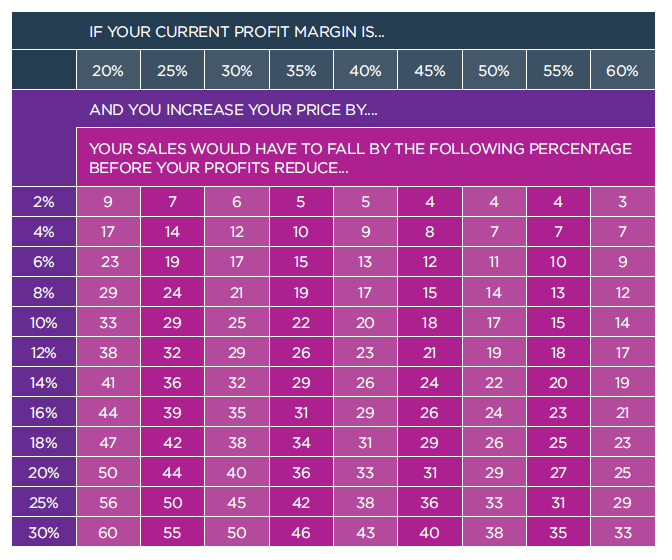(Filmed during the first Lockdown, this content is just as relevant as we come out of the Omicron restrictions and the uncertainty caused by surging case numbers.)
As we emerge into more normal trading conditions, pricing could be the difference between profit and loss.
To understand why it’s so important, it’s probably easier to look first at how you can set your business’s prices. There are different methods to use, and the reality is that the best solution is potentially a combination of those.
In this video, and the extra, extended content below, we’ll look at the different ways to set your prices, and the other influencing factors too…
Cost Plus Pricing
This is actually a useful ‘minimum price’ starting point, to avoid selling at a loss.
As the name suggests to get to this price point, you’d calculate all of your overhead costs, and then add a margin for profit.
Margin Retail
Work out the cost of making your product, including raw materials and the time taken, and add an amount for overheads. To get to the overheads amount to include per item, work out what your total overheads are and divide by the number of sales you expect to make.
When you add your profit margin, that will give you your target price; is this realistic for you to charge?
Hourly Rate
This is the most common way to work out pricing, particularly in a service industry.
- How many hours do you want to work?
- How many of those hours would be chargeable, allowing for admin, travel, marketing etc.
- What costs would you incur?
- What profit would you like to make?
Adding together your costs and profit target, and dividing that by the number of chargeable hours, will give you your required hourly rate.
When you get to that point for the first time, you’d probably want to go back and review some of the other numbers that you put into that calculation, because sometimes the number that pops out is quite a shock!
Market Reaction
You need to know what the market will consider your product or service to be worth, so will need to do some research. There are some products or services that buyers expect to pay more for. If your price is lower, they may well question the quality.
You are really looking at the risk that a customer would perceive in trying your product or service. Guarantees can overcome that perception of risk.
Worth mentioning here is that it’s your customer’s perception, not yours, that you need to take account of. You do need to put yourself in their shoes!
Competitors
We would never advocate setting your prices based on your competitors’ pricing.
You won’t know exactly how their business is performing, and could be following them to financial ruin!
At the moment though, you might find that your pre-pandemic competitors may not be coming out of lockdown in the same way.
Make sure that you’re aware of what your competitors are doing in terms of just activity etc, as we come through lockdown.
- Are they still there?
- What do their products and service look like post-lockdown?
- How does their positioning compare to yours?
Pricing Mistakes
In truth, there are lots of ways in which business owners perhaps don’t utilise pricing in the best way. These include mindset, that can really make business owners freeze as far as their pricing is concerned. What sort of mistakes do people make?
- Using textbook formulas, industry norms, or other ‘standard’ ways to set prices.
- Being too concerned about competitors’ lower prices.
- Actively attracting customers whose primary focus is price.
- Having a (possibly incorrect) preconception about what customers will actually pay.
- Not differentiating enough, and therefore allowing price comparisons.
- Failing to offer a Premium Product / Service, or fully educating customers about your full range.
- Not reviewing prices regularly or taking opportunities to increase when or if it would be relatively easy to do so.
- Overlooking the positive impact to profit of a small increase per customer or transaction.
- Doubting the value of your own offer, and failing to value it sufficiently to justify an increase in prices.
If any of those feel familiar, addressing them could make a real difference to your business!
Pent-up Demand
So for some businesses, as we come out of lockdown, this is HUGE!
Can you take advantage of it?
It may be that you can justify increasing your prices for your first bank of appointments, perhaps in the first week, or your first fortnight.
There are people that are coming out of lockdown that have cash that they want to spend. If you can take deposits from people to make sure that when they are booking an appointment, there are two big benefits.
- You know they’ll arrive! Your highly prized slots of time are going to actually be used and you’re not going to be sitting there twiddling your thumbs because a customer hasn’t turned up.
- If you think back to the cash conversion cycle that we talked about in an earlier episode, it means that you’re getting the cash into your bank account earlier in the cycle.
How can you Differentiate?
This is particularly relevant to be able to justify increasing your prices, or maintaining your previous price point.
It may be that you can stack the value. You may be able to add different features to your standard service, or differentiate yourself in some way to your competition. This means that it’s actually far more difficult for potential customers to compare you with somebody else.
If your offer looks very different, then it takes that comparison out of the equation.
Intangibles
This is the part of pricing that a lot of people overlook!
Intangibles are paramount to really being able to charge a premium price.
But what are they?
There are the things that are really difficult to put a monetary value onto.
- It’s the experience that the customer has when they work with you,
- It’s how you make them feel and the confidence that you give them or that your product gives them.
- It’s the relationship and the trust that they have in you potentially as an individual, as a brand, as a product.
It’s the intangibles that make reviews so beneficial. In most cases it’s the intangibles that people talk about.
Think about your intangibles and think about how you can make sure that you’re making the most of them.
The Impact of Increasing Prices
If you’re thinking about increasing your pricing, either now or later, it’s natural to worry that you’ll lose customers as a result.
It’s actually highly unlikely that you would lose more customers than the benefit that you’d gain from the increased price.
The table below illustrates quite nicely how this might work, and how many customers you’d need to lose to actually lose out on the benefits of a price increase, depending on your current profit margin:

Additional Benefits
If you make more profit from fewer customers, it follows through that you may actually have a corresponding reduction in your overheads.
- There may be less admin involved if you’re dealing with less people.
- There could be less calls coming in, so you’re getting less distractions.
- You’d need less leads coming in…
What about your Premium Product?
Finally, have a think about whether there is a premium product within your business that you’re not actually promoting, or making available just yet.
And by premium product, what I mean is a service level or a product option that actually is above your current top premium offer.
There will always be people within your customer base that will happily pay more for your service.
Your job is to make sure that you have that ever increasing level for those people to buy.
Equally, make sure that all of your customers understand your full product range or service range. It’s surprising how many times we hear from clients that they missed out on a sale because somebody didn’t realise that they offered that product or that service. Customers need to be reminded of all of the different ways you can help them!
NOW is the time to make sure that all of your existing customers know what exactly you are able to offer to them. They already know you, trust you and have a relationship with you so they are far more likely to buy again.
Be Selective
You could raise your prices on one element within the business, maybe one product, one service, or maybe one market that you sell to. There’s no rule that says you can’t!
The Bottom Line
If you can find a way of increasing your sales by £1,000 by increasing your prices, that £1,000 goes straight to your profit line.
You’re not increasing your costs to increase your income, and in an environment where costs are going up, it’s really important to try and find all those little edges that could make a big difference.
If you do find those little extras, and take any opportunity to bring those funds into your business earlier in the cash cycle, as mentioned above, you’ll be able to see the improvement in your cash flow. If you haven’t yet set up a process to monitor your cash flow, you can find out about that here.
Reviewing your pricing right now might seem a bit of a strange thing to think about. We’ve all got so much else going on, coming out of lockdown and coming back into this new normal with social distancing and reduced footfall and all that that might involve.
Reviewing your prices can make a real difference though, and that could be the difference between making a profit this year or not.
This has been a real whistle-stop tour of pricing. It’s not straightforward, but if you’d like to talk about it and relate all of this directly to your business, then please do get in touch.
Similarly, if you’re not a client of ours, then please do speak to your own accountant about this. They should be having conversations with you about your pricing anyway, but do go and speak to them because it is something that can make a real difference to any business particularly right now.
Going forwards, pricing should be something that you’re looking at on a regular basis, but a lot of business owners don’t do it. As I hope I’ve explained, it’s an area that can make a real difference, now and for the future.
Business News
We send regular updates that keep clients aware of changes and suggestions on a wide range of subjects; if you’d like to receive those too, just add your details below and we’ll do the rest! We promise not to bombard you and you can unsubscribe at any time.




